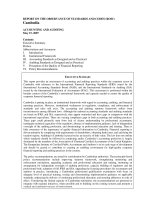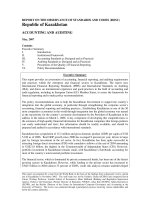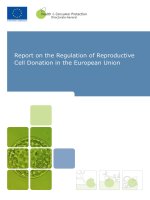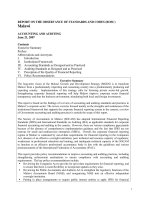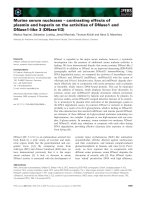Internship report on merchandising activities of shelltex international
Bạn đang xem bản rút gọn của tài liệu. Xem và tải ngay bản đầy đủ của tài liệu tại đây (2.52 MB, 125 trang )
Shelltex International Page 1
Introduction
Chapter 1
Shelltex International Page 2
“Merchandising Business in Ready Made Garments”- A
case study on Shelltex International”.
Shelltex International Page 3
1.1 Background of the Study
The garments industry of Bangladesh has been the key export division and a main source of
foreign exchange for the last 35 years. At present, the country generates about $6 billion worth of
products each year by exporting garment. The industry provides employment to about 3 million
workers of whom 90% are women. Two non-market elements have performed a vital function in
confirming the garment industry's continual success; these elements are (a) quotas under Multi-
Fibred Arrangement1 (MFA) in the North American market and (b) special market entry to
European markets. The whole procedure is strongly related with the trend of relocation of
production. It has been reveals that the tendency of low labor charges is the key reason for the
transfer of garment manufacturing in Bangladesh. Bangladesh Garment Sector and Global Chain
The cause of this transfer can be clarified by the salary structure in the garment industry, all over
the world. Apparel labor charge per hour (wages and fringe benefits, US$) in USA is 10.12 but it
is only 0.30 in Bangladesh. This difference accelerated the world apparel exports from $3 billion
in 1965, with developing nations making up just 14 percent of the total, to $119 billion in 2001,
with developing nations contributing 59 percent. In 1991 the number of workers in the ready-
made garment industry of Bangladesh was 582,000 and it grew up to 1,404,000 in 1998. In USA,
however, 1991-figure showed 1,106.0 thousand workers in the apparel sector and in 2008 it
turned down to 765.8 thousand.
Shelltex International Page 4
1.2 Objective of the Study
The objective of the case study is to develop the concept about the various aspects of the
organizational structure, success & marketing process of the garments industry. This case study
will help me to analyze the various concept of marketing, formal hierarchy, standardized export
policies & rules, organizational network, various types of approaches to make profit, decision
making in stable & unstable situation, how to improve the quality of products & the production
process which will enrich my experience for my future career.
1.3 Scope of the Study
During my internee period I have got chances to visit many buying house, factory, supervise
much production process, & completed many sample program. And Inshallah, I will get a job in
LE as asst. merchandiser & as an assistant merchandiser; I will try to elaborate the
merchandising profession and the production and marketing process of a garments factory.
1.4 Methodology
Data instrument
As the raw data is being collected by personal interview with various employee & buyer of
different company and buying house, it was analyzed by the Microsoft office. This program was
also used for the table a graphical presentation.
Beside those, the universal report writing software MS WORD was used to process all necessary
research writing, charts graphs and tables.
To formulate the research problem I have constitute the following steps:
Data collection procedure
The source of data or information we divided into two parts that are primary and secondary
source.
Shelltex International Page 5
Source of Data
Figure: Sources of data
Both primary and secondary data sources were used to generate this report.
Primary data
In the primary source data are collected directly from Shelltex International
Secondary data
Secondary data are collected through different website journal and textbook and other data also
collect by going various buying house.
The Primary sources are follows:
Primary data are measurements observed and recorded as part of an original study. When the
data required for a particular study can be found neither in the internal records of the enterprise,
nor in published sources, may it become necessary to collect original data. For the completion of
this report, the primary sources of data are-
* Face-to-face conversation with the respective officers and staffs
* Informal conversation with the clients.
* Practical work exposures from the different desks of the departments .
* Study of the relevant files as instructed as instructed by the officers concerned
PRIMARY
DATA
SECONDARY
DATA
Shelltex International Page 6
* Experts‟ opinion and comments,
The Secondary sources and data are follows:
The data which has already been collected by others, such data are called Secondary data. For
this internship report, the secondary data are collected from the below sources-
* Training materials available at the garments,
* Various books articles, compilations etc. regarding marketing of financial products are
informed below:
* Published of different products,
* Office circular and other published papers,
Methodology used
There are various methodology that I have used to analyze performance are
Ratio Analysis
BCG Matrix
SWOT Analysis
.
1.5 Limitations of the Study
It‟s very hard to find necessary information because there are no fixed place such as
library where data is kept.
Foreign buyers English are not that much clear.
The answer of certain questions I had go through people's opinion. While doing the
survey lots of people did not want to respond to many questions. Sometimes they even
did not fill out the questionnaire properly for the busy schedule.
Time was one of the major constraints. As our internship program is only three-month
Shelltex International Page 7
long, it was difficult to cover and collect all the necessary materials for completion of
such a large report within this time boundary.
The people of Merchandising Incorporation are under tremendous workload. Although,
they wanted to cooperate with me in writing my report, their busy schedules sometimes
did not allow them to do so. On the other hand, due to secrecy of official information,
sometimes they showed unwillingness to provide me information.
There are many code names in garments industry that is very important for production
process, and I have memorized those codes.
In garments factory most of the employee doesn‟t have any educational background they
do their job only with experiences.
Political unrest of our country such as strike or hartal was major problem in this regard as
it is difficult to go out and work during that time and to maintain the work schedule.
Shelltex International Page 8
An overview of
Merchandising in Ready
Made Garments Sector in
Bangladesh
Chapter 2
Shelltex International Page 9
2.1 The concept of merchandising in general terms:
Merchandising is the methods, practices, and operations used to promote and sustain certain
categories of commercial activity
There are:
1) Promotional merchandising
2) Trading industry
3) Retail supply chain
4 Licensing
a) Children
b) Adults
2.1.1 Promotional merchandising:
In retail commerce, visual display merchandising means maximizing merchandise sales using
product design, selection, packaging, pricing, and display that stimulate consumers to spend
more. This includes disciplines in pricing and discounting, physical presentation of products and
displays, and the decisions about which products should be presented to which customers at what
time.
This annual cycle of merchandising differs between countries and even within them, particularly
relating to cultural customs like holidays, and seasonal issues like climate and local sporting and
recreation.
In the United States for example, the basic retail cycle begins in early January with merchandise
for Valentine's Day, which is not until mid-February. Following this, Easter is the major holiday,
while springtime clothing and garden-related merchandise is already arriving at stores, often as
early as mid-winter. Mothers Day and Fathers Day are next, with graduation gifts (typically
small consumer electronics like digital cameras) often being marketed as "dads and grads" in
June (though most semesters end in May). Summer merchandise is next, including patriotic-
themed products with the American flag, out by Memorial Day in preparation for Independence
Day (with Flag Day in between).
Shelltex International Page 10
By July, back-to-school is on the shelves and autumn merchandise is already arriving, and at
some arts and crafts stores, Christmas decorations. By September, the summer merchandise is on
final closeout and overstock of school supplies is marked-down some as well, and Halloween
(and often even more of the Christmas) merchandise is appearing. As the Halloween decorations
and costumes dwindle in October, Christmas is already being pushed on consumers, and by the
day afterward retailers are going full-force with advertising, although the "official" season does
not start until the day after Thanksgiving. Christmas clearance sales now begin even before
Christmas at most retailers, and continue on to as little as New Year's Day or as long as
February.
Merchandising also varies within retail chains, where stores in places like Denver, Minneapolis,
or Buffalo might carry snow blowers, while stores in Florida and southern California might
instead carry beach clothing and barbecue grills all year. Coastal-area stores might carry water
skiing equipment, while ones near mountain ranges would likely have snow skiing and
snowboarding gear if there are ski areas nearby.
2.1.2 Trading industry:
In Eastern Europe, particularly in Russia, the term “merchandising” is commonly used within the
trading industry and denotes all marketing and sales stimulation activities around PoS (point of
sale): design, creation, promotion, care and training of the sales staff. Basically a merchandiser is
someone who is continuously involved in business promotion by buying and selling of goods.
2.1.3 Retail supply chain:
In the supply chain, merchandising is the practice of making products in retail outlets available to
consumers, primarily by stocking shelves and displays. While this used to be done exclusively by
the stores' employees, many retailers have found substantial savings in requiring it to be done by
the manufacturer, vendor, or wholesaler that provides the products to the retail store. In the
United Kingdom there are a number of organizations that supply merchandising services to
support retail outlets with general stock replenishment and merchandising support in new stores.
By doing this, retail stores have been able to substantially reduce the number of employees
needed to run the store.
Shelltex International Page 11
While stocking shelves and building displays is often done when the product is delivered, it is
increasingly a separate activity from delivering the product. In grocery stores, for example,
almost all products delivered directly to the store from a manufacturer or wholesaler will be
stocked by the manufacturer's/wholesaler's employee who is a full time merchandiser. Product
categories where this is common are Beverage (all types, alcoholic and non-alcoholic), packaged
baked goods (bread and pastries), magazines and books, and health and beauty products. For
major food manufacturers in the beverage and baked goods industries, their merchandisers are
often the single largest employee group within the company. For nationwide branded goods
manufacturers such as The Coca-Cola Company and PepsiCo, their respective merchandiser
work forces number in the thousands.
2.1.4 Licensing:
In marketing, one of the definitions of merchandising is the practice in which the brand or image
from one product or service is used to sell another. Trademarked brand names, logos, or
character images are licensed to manufacturers of products such as toys or clothing, which then
make items in or emblazoned with the image of the license, hoping they'll sell better than the
same item with no such image. For the owners of the intellectual property in question,
merchandising is a very popular source of revenue, due to the low cost of letting a third party
manufacture the merchandise, while the IP owners simply sit back and collect the merchandising
fees.
Children:
Merchandising for children is most prominently seen in connection with films and games,
usually those in current release and with television shows oriented towards children.
Merchandising, especially in connection with child-oriented films and TV shows, often consists
of toys made in the likeness of the show's characters (action figures) or items which they use.
However, sometimes it can be the other way around, with the show written to include the toys, as
advertising for the merchandise. The first major example of this was the TV show "He-man and
Shelltex International Page 12
the Masters of the Universe," in the early 1980s, but this practice has been common in children's
broadcasting ever since.
Sometimes merchandising from a television show can grow far beyond the original show, even
lasting decades after the show has largely disappeared from popularity. In other cases, large
amounts of merchandise can be generated from a pitifully small amount of source material
(Mashimaro).
Adults:
Example of professional sports merchandising - A Boston Celtics cap manufactured by Adidas
The most common adult-oriented merchandising is that related to professional sports teams (and
their players).
A smaller niche in merchandising is the marketing of more adult-oriented products in connection
with similarly adult-oriented films and TV shows. This is common especially with the science
fiction and horror genres. (Examples: Star Trek, McFarlane Toys) Occasionally shows which
were intended more for children find a following among adults, and you can see a bit of a
crossover, with products from that show oriented towards both adults and children. (Gundam
model kits)
Sometimes a brand of non-media products can achieve enough recognition and respect that
simply putting its name or images on a completely unrelated item can sell that item. (An example
would be Harley-Davidson branded clothing.)
Shelltex International Page 13
2.1.5 A Glimpse of The Growth & Status of Ready-Made Garment Export of
Bangladesh:
Year
Export of RMG (in
Million US$)
Total export of Bangladesh
(in Million US$)
% of RMGS to total Export
1987-88
31.57
811.00
3.89
1988-89
116.20
934.43
12.44
1989-90
131.48
819.21
16.06
1990-91
298.67
1076.61
27.74
1991-92
433.92
1231.20
35.24
1992-93
471.09
1291.56
36.47
1993-94
642.16
1523.70
40.96
1994-95
866.82
1717.55
50.47
1995-96
1182.57
1993.92
59.31
1996-97
1245.01
2382.89
60.64
1998-99
1555.79
2533.90
61.40
1999-2002
2547.13
382.00
65.61
2002-2004
3001.25
4418.28
67.93
2004-2006
3781.94
5161.20
73.28
2006-2008
4019.98
5212.86
75.67
Shelltex International Page 14
2.1.6 Apparel-The Highest Export Earning Sector:
1991-92
RMG EXPORT VALUE (MILLION US
$)
1991-92
1182.57
1998-99
1445.22
1999-98
1555.79
1998-99
2232.09
1999-2000
2547.13
2000-2001
3001.25
2001-2002
3781.94
2002-2003
4019.98
2.1.7 Share of RMG In Country's 1998-99 Total Export:
Commodity
Export Share (%)
RMG
75.67
JUTE GOODs
5.72
RAW JUTE
5.16
TEA
1.35
LEATHER
3.17
Shelltex International Page 15
CHEM. PRODUCTS
0.72
FROZEN GOODS
1.49
OTHERS
12.91
2.2 History
The ready-made garment (RMG) industry of Bangladesh started in the late 1970s and became a
prominent player in the economy within a short period of time. The industry has contributed to
export earnings, foreign exchange earnings, employment creation, poverty alleviation and the
empowerment of women. The export-quota system and the availability of cheap labour are the
two main reasons behind the success of the industry. In the 1980s, the RMG industry of
Bangladesh was concentrated mainly in manufacturing and exporting woven products. Since the
early 1990s, the knit section of the industry has started to expand. Shirts, T-shirts, trousers,
sweaters and jackets are the main products manufactured and exported by the industry.
Bangladesh exports its RMG products mainly to the United States of America and the European
Union. These two destinations account for more than a 90 per cent share of the country‟s total
earnings from garment exports. The country has achieved some product diversification in both
the United States and the European Union. Recently, the country has achieved some level of
product upgrading in the European Union, but not to a significant extent in the United States.
Bangladesh is less competitive compared with China or India in the United States and it is
somewhat competitive in the European Union.
The phase-out of the export-quota system from the beginning of 2005 has raised the
competitiveness issue of the Bangladesh RMG industry as a top priority topic. The most
important task for the industry is to reduce the lead time of garment manufacturing. The
improvement of deep-level competitiveness through a reduction in total “production and
distribution” time will improve surface-level competitiveness by reducing lead time. Such a
strategy is important for long-term stable development of the industry, but its implementation
will take time. In contrast, the establishment of a central or common bonded warehouse will
improve surface-level competitiveness by reducing lead time, but deep-level competitiveness
will not be improved and long-term industry development will be delayed. Therefore, granting
permission to establish in the private sector such warehouses with special incentives, such as the
duty-free import of raw materials usable in the export-oriented garment industry for reducing the
lead time in garment manufacturing is a critical issue for Bangladesh. Second, Bangladesh needs
to improve the factory working environment and various social issues related to the RMG
industry. International buyers are very particular about compliance with codes of conduct. Third,
Shelltex International Page 16
issues related to product and market diversification as well as upgrading products needs to be
addressed with special care. Moreover, the Government of Bangladesh needs to strengthen its
support. The development of the port and other physical infrastructure, the smooth supply of
utilities, a corruption-free business environment and political stability are some priority concerns
for the Government to consider in its efforts to attract international buyers and investors.
The RMG industry of Bangladesh has expanded dramatically over the last three decades.
Traditionally, the jute industry dominated the industrial sector of the country until the 1970s.
Since the early 1980s, the RMG industry has emerged as an important player in the economy of
the country and has gradually replaced the jute industry. The “export-quotasystem”1 in trading
garment products played a significant role in the success of the industry. However, that quota
system came to an end in 2004. Therefore, the competitiveness issue needs to be addressed, with
special attention given to the long-term sustainability of the industry. The term
“competitiveness” itself is a broad concept. Its meaning, implications, adaptation and
achievement vary from firm to firm, industry to industry, or country to country. Michael E.
Porter is a pioneer of the “competitiveness theory” (Porter, 1990)at the national or macro level
(Cho and Moon, 2000). Firm/industry-level (micro level) competitiveness depends on various
parameters. However, the literature provides no universal agreement on the definition of
competitiveness. For example, some researchers consider the labor cost, unit cost, exchange rate,
interest rate, prices of material inputs other price- or cost-related quantitative factors for
measuring the competitiveness of a manufacturing firm/industry (Edwards and Golub , 2004;
Fukunishi, 2004; Cockburn another‟s, 1998; and Edwards and Schoer, 2002). Some other
researchers consider product quality, innovativeness, design, distribution networks, after-sales
service, transaction costs, institutional factors relating to the bureaucracy of export procedures
and other non-price factors for measuring the competitiveness of a manufacturing firm/industry
(Abdel-Latif,1993; Chen and others, 1999; and Sachwald, 1994). The influences of both price
and on-price factors on the competitiveness of a firm/industry are reflected by market share and
profit ( 2006). This study attempts to incorporate price, non-price and result(for example, market
share) factors in order to address the international competitiveness of the Bangladesh RMG
industry. The majority of the competitiveness-related research studies focus on the “competitive
performance” or on the “factors influencing competitive performance”. The studies consider
product price, market share and other indicators to measure competitive performance, while
considering wages, costs, productivity and other issues as factors influencing competitive
performance. However, Fujimoto (2001) puts special emphasis on the “capability” factor that
influences the competitive performance of a firm. According to him, improvement in the
“capability” of a firm enhances its “competitive performance”. This improvement takes time, but
it ensures the long-term sustainability of a firm. In contrast, improving only “competitive
performance” and not “capability” may not be sufficient to ensure the long-term development of
the firm.
Shelltex International Page 17
This study addresses the competitiveness issue from two broader dimensions: surface-level and
deep-level competitiveness.3 Surface-level competitiveness reflects the “competitive
performance” of a firm or industry that is directly observable to consumers. Deep-level
competitiveness reflects the “capability” of a firm or industry that is not directly observable to
consumers. An improvement in the deep-level performance enhances the performance at the
surface level. The severe competition under the quota-free trading environment pressures the
RMG industry of Bangladesh to enhance its surface-level competitiveness at the earliest
convenient time. However, the long-term sustainability of the industry demands enhancement of
deep-level competitiveness. Therefore, the future development of the industry will depend on
how much importance will be given to which factors/dimensions, and how the individual firms
will respond and how government policies will influence the industry. Hence, the discussion of
the competitiveness of the Bangladesh RMG industry requires simultaneous consideration of
both the surface and deep dimensions. In particular, this study uses (a) export value, product
price, market share and lead time as surface-level indicators, and (b) linkage expansion, factory
environment, product/market composition, and “production and distribution” time as deep-level
indicators for measuring the international competitiveness of the Bangladesh RMG industry. The
paper is structured as follows.
2.3 AN OVERVIEW OF THE BANGLADESH READYMADE GARMENT
INDUSTRY:
The RMG industry is the only multi-billion-dollar manufacturing and export industry in
Bangladesh. Whereas the industry contributed only 0.001 per cent to the country‟s total export
earnings in 1976, its share increased to about 75 per cent of those earnings in 2005. Bangladesh
exported garments worth the equivalent of $6.9 billion in2005, which was about 2.5 per cent of
the global total value ($276 billion) of garment exports. The country‟s RMG industry grew by
more than 15 per cent per annum on average during the last 15 years. The foreign exchange
earnings and employment generation of the RMG sector have been increasing at double-digit
rates from year to year. Some important issues related to the RMG industry of Bangladesh are
noted in table
Table 2. Important issues related to the ready-made garment industry
Year(s) Issue
1977-1980 Early period of growth
1982-1985 Boom days
1985 Imposition of quota restrictions
1990s Knitwear sector developed significantly
1993-1995 Child labor issue and its solution
2003 Withdrawal of Canadian quota restriction
2005 Phase-out of export-quota system
Shelltex International Page 18
Currently, there are more than 4,000 RMG firms in Bangladesh. More than 95 percent of those
firms are locally owned with the exception of a few foreign firms located inexpert processing
zones (Gonzales, 2002). The RMG firms are located mainly in three main cities: the capital city
Dhaka, the port city Chittagong and the industrial city Narayangonj. Bangladesh RMG firms
vary in size. Based on Bangladesh Garment Manufacturers and Exporters Association (BGMEA)
data, (2000) found that in1997 more than 75 per cent of the firms employed a maximum of 400
employees each. Garment companies in Bangladesh form formal or informal groups. The
grouping helps to share manufacturing activities, to diversify risks; horizontal as well as vertical
coordination can be easily found in such group activities. Ready-made garments manufactured in
Bangladesh are divided mainly into two broad categories: woven and knit products. Shirts, T-
shirts and trousers are the main woven products and undergarments, socks, stockings, T-shirts,
sweaters and other casual and soft garments are the main knit products. Woven garment products
still dominate the garment export earnings of the country. The share of knit garment products has
been increasing since the early 1990s; such products currently account for more than 40 per cent
of the country‟s total RMG export earnings (BGMEA website). Although various types of
garments are manufactured in the country, only a few categories, such as shirts, T-shirts,
trousers, jackets and sweaters, constitute the major production-share (BGMEA website).
Economies of scale for large-scale production and export-quota holdings in the corresponding
categories are the principal reasons for such a narrow product concentration.
2.4 COMPETITIVENESS OF THE BANGLADESH READY-
MADEGARMENT INDUSTRY:
The United States was the main export destination for Bangladeshi RMG products in the early
1990s followed by the European Union, but the European Union has surpassed the United States
over time. These two destinations generate more than 90 per cent of the total RMG export
earnings of Bangladesh (BGMEA and the Export Promotion Bureau websites; and Quddus and
Rashid, 2000). The shares of other importers, such as Australia, Canada, China, Japan and the
Russian Federation as well as countries in the Middle East, in the total RMG export earnings of
Bangladesh are minimal. This section of the paper focuses on surface-level competitive
performance of the Bangladesh RMG industry in the United States and the European Union
markets only. In addition, the performance of China and India along with Bangladesh as RMG
suppliers to international markets is also considered for comparative analysis. (a) Export
competitiveness in the United States market5 Bangladesh has experienced some product
diversification in its export of garments to the United States market in recent years compared
with the early 1990s.6 However, the country‟s performance in upgrading its products is not
significant with regard to the United States market (Haider, 2006). The country experienced a
sharp increase in the export of garment products to the United States market in the 1990s, but
faced declines in export earnings from that country in 2002 and 2003, followed by slow increases
since 2004. The exports of India also increased rapidly in the 1990s, although that country
experienced comparatively slow progress in the last few years. However, the RMG exports of
China to the United States have increased at a startling rate over the years. For example, the
textile and garment export earnings of China, India and Bangladesh from the United States were
Shelltex International Page 19
$3.6 billion, $0.8 billion and $0.4 billion respectively in 1990, and increased to$22.4 billion, $4.6
billion and $2.5 billion respectively in 2005. Such rapid expansion in the exports of China
represents a major challenge to other exporters.
Cotton non-knit shirts, man and boy was the highest contributor to the export earnings of
Bangladesh from the United States, amounting to $332 million in2005. The export earnings of
only eight categories8 crossed the $100 million export benchmark in the same year for the
country. A total of 16 categories of exports crossed the$50 million benchmark and 31 categories
crossed the $10 million export benchmark.
2.4.1 Export competitiveness in the European Union market:
Bangladesh has experienced both quantitative and qualitative changes in exporting garment
products to the European Union market during the period 1996-2005. The textile and garment
export earnings of Bangladesh from the European Union increased from1.2 billion Euros in 1996
to 3.7 billion Euros in 2005. For India and China, the corresponding earnings increased from 3
billion and 5.3 billion Euros in 1996 to 5.3 billion and 21.1 billion Euros in 2005 respectively.
Garment products generate the major share of Bangladesh‟s export earnings from the European
Union. However, both textile and garment products in China and India contribute to the export
earnings from the European Union. For example, garment products on average generated more
than a 95 per cent share of the total textile and garment exports to the European Union from
Bangladesh during the period1996-2005. The corresponding shares for India and China stand at
below 75 per cent and80-90 per cent respectively. The top five product groups contributed 76 per
cent of the total garment export earnings of Bangladesh from the European Union in 1996, and
that share increased to82 per cent in 2005. The corresponding changes for India and China were
from shares of62 per cent and 34 per cent in 1996 to 54 per cent and 45 per cent in 2005
respectively. This trend demonstrates that product diversification in Bangladesh is lower than
that of India and China in exporting garments products to the European Union market. Knit
garments from Bangladesh have gained remarkable access to the European Union market during
the period 1996-2005 (see table 2).Duty- and quota-free access of garment products
manufactured under “two-stage local transformation” (yarn to fabrics, and fabrics to garment)
have accelerated the exports of knit garment products from Bangladesh to the European Union.
As the knit textile subsector is relatively less capital intensive and requires relatively simple
technologies, it managed to undergo rapid expansion, benefiting from the European Union
Generalized System of Preferences. The woven part of the category has failed to utilize that
facility owing to a lack of sufficient backward linkages. In contrast to the European Union, both
knit and non-knit products have entered the United States market simultaneously, as no special
tariff or tax reduction incentive was available there for the import of garment products from
Bangladesh. The product-mix of garment products exported from Bangladesh to the European
Union has changed significantly during the period 1996-2005. The share of shirts in total
garment exports from Bangladesh to the European Union has decreased, whereas the shares for
Shelltex International Page 20
overcoats, jackets, sweaters, suits and some other garment products have increased indecent
years. These changes demonstrate that Bangladesh is achieving some level of product
diversification in exporting garment products to the European Union. In addition, a gender
analysis indicates that Bangladesh has achieved some upgrading of its products recently in terms
of exporting garment products to the European Union. Garments for females are treated as
upgraded products compared with garments for males, since they add more value on average.
The earnings of Bangladesh from the export of garments for females to the European Union has
increased during the period 1996-200.
Table- 3 Exports of knit, non-knit and made-up products to the European
Union
(Millions of Euros and percentage)
Exporter to
the European
Union
Year
Knit
garments
Total %
Non-Knit
garments
Total %
Made- up
products
Total %
Total
Total %
Bangladesh
India
China
1996
2005
1996
2005
1996
2005
506 44
2195 60
510 28
1508 38
1538 34
6639 36
624 54
1334 36
1012 55
1720 44
2488 56
10178 55
29 2
132 4
320 17
714 18
432 10
1748 9
1159 100
3661 100
1842 100
3942 100
4458 100
18565 100
2.4.2 Price competitiveness:
China and some other competitors of Bangladesh have implemented sharp price-cutting policies
in exporting garment products over the last few years, but Bangladesh has failed to respond
effectively to such policies. China was able to drop the export price of29 garment categories10
Shelltex International Page 21
by 46 per cent11 on average in the United States within a year, from $6.23 per sq meter in
December 2001 to $3.37 per sq meter in December 2002.However, all other suppliers were able
to drop the price by only 2 per cent, from $3.50 per sq meter to $3.41 per sq meter during the
same period. By the end of 2002, China had underpriced all other exporters to the United States
in 22 out of 29 garment categories and it had underpriced others in 26 out of 29 categories by
March 2003 (American Textile Manufacturers Institute, 2003). Moreover, China rapidly
managed to be price competitive in the European Union and other major international markets.
For example, the average unit export price of garment products integrated in the third stage of
the Multi fiber Arrangement phase-out decreased from 11,600 Euros per ton in 2001 to 9,500
Euros in 2002 for Bangladesh in the European Union, whereas the corresponding decrease for
China in that market was from 13,500 Euros to 8,800 Euros per ton (European Commission,
2003). Bangladesh needs to respond to such price-cutting policies of its rivals in order to remain
competitive in the quota-free global market. (d) Lead time Lead time refers to the time required
for supplying the ordered garment products after the export order has been received. In the
1980s, the usual lead time in the garment industry was 120-150 days for the main garment
supplier countries of the world; it has been reduced to 30-40 days in the current decade.12
However, in this regard the Bangladesh RMG industry has improved little; for example, the
average lead time is 90-120 days for woven garment firms and 60-80 days for knit garment
firms. In China, the average lead time is 40-60 days and 50-60 days for woven and knit products
respectively; in India, it is 50-70 days and 60-70 days for the same products
respectively.13Shortening the lead time is the most urgent priority task for Bangladesh. The best
way is to develop domestic backward linkages with the aim of reducing “production and
distribution” time.14 Such a strategy would contribute to enhancing the deep-level performance
of the industry and would have a positive impact on surface-level performance. An alternative
solution would be to establish a central or common bonded warehouse in the private sector for
storing raw materials usable in the export-oriented garment industry, with special incentives such
as duty-free import. While such a solution is the fastest way to improve surface-level
competitiveness by reducing lead time, it carries the risk of delaying deep-level competitive
performance-enhancing initiatives and the long-term development of the industry.
Shelltex International Page 22
Literature review
Chapter 3
Shelltex International Page 23
3.1 Letter of Credit (LC):
Letter of credit (LC) is a financial instrument opened by importer.
LC can be opened in favor of exporter. It gives assurance that the importer is solvent.
Most of the LC is irrevocable. An irrevocable LC means that once the exporter has
accepted the credit, the buyer cannot alter it without any permission of exporter.
Transaction of letter of credit (LC)
7. Authorization of payment
2. LC
3. Document 1. Request
5. Of To open LC 8. Debited
6. LC
1. shipment
4. SHIPMENT
Of good
Exporter Bank
Importer Bank
Exporter
Importer
Shelltex International Page 24
1. Buyer requests the bank for open a letter of credit.
2. Issuing bank open an irrevocable LC and send it to exporter bank.
3. Advising bank prepare letter of conformation of LC and send it to exporter
4. Exporter review the LC. IF acceptable, exporter arranges with freight
forwarder to delivery the goods.
5. Exporter present delivery documents to advising bank for payment.
6. Advising bank forward the entire document to issuing bank to authorize
payment.
7. At the same time, advising bank pays necessary payment to exporter.
8. 8 buyers account in the issuing bank is debited
3.2 Terms of LC:
C.I.F (Cost, Insurance and freight):
Charge by the exporter- the goods, transportation, insurance, miscellaneous etc.
Must mention a delivery point up to where the exporter will bear the cost of freight.
C.F (Cost and Freight)
The exporter quotes a price including the cost of goods and transportation.
The insurance cost by importer.
Importer knows such insurance company who offer lower insurance price.
F.O.B (Free on Board)
F.O.B means exporter will take the responsibility up to the goods are loaded on the ship
Importer has own transportation
Ship company is well known to importer
Commercial invoice:
Commercial invoice is the final bill that allows the importer about how to pay to exporter.
Commercial invoice is needed customs to impose tax.
Bill of lading:
A bill of lading is a documents issued by the ship-owner or by the master or captain of the ship
or other agent in exchange of mate‟s Receipt after the goods have been placed on the board the
ship for being carried to a specific destination. It is used when the goods shipped from only a
part of the cargo of a „general ship‟
Shelltex International Page 25
A bills of lading must be stamped and signed by the ship-owner or his agent, the master or
captain of the ship
Backward Integration:
Customers are another potential source of competition. For reducing the production cost
manufacturer make linkage or own the source of raw materials. Those linkages are called
backward linkage or backward integration.
Labor-Capital relationship:
In countries where there is little capital available for investment and where the amount of
investment per worker is low, manager might expect to find cheap labor rate and export
competitiveness in product that require large amount of labor relative to capital.


